Flexible Magnetic Metasurface with Defect Cavity for Wireless Power Transfer System
Abstract
1. Introduction
2. Design and Analysis of Flexible Magnetic Metasurface for Wireless Power Transfer
3. Experiment Results
4. Conclusions
Author Contributions
Funding
Institutional Review Board Statement
Informed Consent Statement
Data Availability Statement
Conflicts of Interest
References
- Song, M.; Jayathurathnage, P.; Zanganeh, E.; Krasikova, M.; Smirnov, P.; Belov, P.; Kapitanova, P.; Simovski, C.; Tretyakov, S.; Krasnok, A. Wireless Power Transfer Based on Novel Physical Concepts. Nat. Electron. 2021, 4, 707–716. [Google Scholar] [CrossRef]
- Song, M.; Belov, P.; Kapitanova, P. Wireless Power Transfer Inspired by the Modern Trends in Electromagnetics. Appl. Phys. Rev. 2017, 4, 021102. [Google Scholar] [CrossRef]
- Bi, Z.; Kan, T.; Mi, C.C.; Zhang, Y.; Zhao, Z.; Keoleian, G.A. A Review of Wireless Power Transfer for Electric Vehicles: Prospects to Enhance Sustainable Mobility. Appl. Energy 2016, 179, 413–425. [Google Scholar] [CrossRef]
- El-Shahat, A.; Ayisire, E.; Wu, Y.; Rahman, M.; Nelms, D. Electric Vehicles Wireless Power Transfer State-of-the-Art. Energy Procedia 2019, 162, 24–37. [Google Scholar] [CrossRef]
- Sun, L.; Ma, D.; Tang, H. A Review of Recent Trends in Wireless Power Transfer Technology and Its Applications in Electric Vehicle Wireless Charging. Renew. Sustain. Energy Rev. 2018, 91, 490–503. [Google Scholar] [CrossRef]
- Xu, D.; Zhang, Q.; Li, X. Implantable Magnetic Resonance Wireless Power Transfer System Based on 3D Flexible Coils. Sustainability 2020, 12, 4149. [Google Scholar] [CrossRef]
- Pham, T.S.; Nguyen, T.D.; Tung, B.S.; Khuyen, B.X.; Hoang, T.T.; Ngo, Q.M.; Hiep, L.T.H.; Lam, V.D. Optimal Frequency for Magnetic Resonant Wireless Power Transfer in Conducting Medium. Sci. Rep. 2021, 11, 18690. [Google Scholar] [CrossRef]
- Chaudhary, K.; Kumar, D. Satellite Solar Wireless Power Transfer for Baseload Ground Supply: Clean Energy for the Future. Eur. J. Futur. Res. 2018, 6, 9. [Google Scholar] [CrossRef]
- Yan, Z.; Zhang, Y.; Zhang, K.; Song, B.; Mi, C. Underwater Wireless Power Transfer System with a Curly Coil Structure for AUVs. IET Power Electron. 2019, 12, 2559–2565. [Google Scholar] [CrossRef]
- Tesla, N. Apparatus for Transmitting Electrical Energy. 1119732, 1 December 1914. [Google Scholar]
- Brown, W.C. The History of Power Transmission by Radio Waves. IEEE Trans. Microw. Theory Tech. 1984, 32, 1230–1242. [Google Scholar] [CrossRef]
- Ko, W.H.; Liang, S.P.; Fung, C.D.F. Design of Radio-Frequency Powered Coils for Implant Instruments. Med. Biol. Eng. Comput. 1977, 15, 634–640. [Google Scholar] [CrossRef]
- Hui, S.Y.R.; Zhong, W.; Lee, C.K. A Critical Review of Recent Progress in Mid-Range Wireless Power Transfer. IEEE Trans. Power Electron. 2014, 29, 4500–4511. [Google Scholar] [CrossRef]
- Kim, C.-G.; Seo, D.-H.; You, J.-S.; Park, J.-H.; Cho, B.-H. Design of a Contactless Battery Charger for Cellular Phone. In Proceedings of the APEC 2000. Fifteenth Annual IEEE Applied Power Electronics Conference and Exposition (Cat. No.00CH37058), New Orleans, LA, USA, 6–10 February 2000; Volume 2, pp. 769–773. [Google Scholar]
- Kurs, A.; Karalis, A.; Moffatt, R.; Joannopoulos, J.D.; Fisher, P.; Soljačić, M. Wireless Power Transfer via Strongly Coupled Magnetic Resonances. Science 2007, 317, 83–86. [Google Scholar] [CrossRef]
- Wang, B.; Teo, K.H.; Nishino, T.; Yerazunis, W.; Barnwell, J.; Zhang, J. Experiments on Wireless Power Transfer with Metamaterials. Appl. Phys. Lett. 2011, 98, 254101. [Google Scholar] [CrossRef]
- Smith, D.R.; Padilla, W.J.; Vier, D.C.; Nemat-Nasser, S.C.; Schultz, S. Composite Medium with Simultaneously Negative Permeability and Permittivity. Phys. Rev. Lett. 2000, 84, 4184–4187. [Google Scholar] [CrossRef]
- Veselago, V.G. The Electrodynamics of Substances with Simultaneously Negative Values of ɛ and μ. Sov. Phys. Uspekhi 1968, 10, 509. [Google Scholar] [CrossRef]
- Huang, C.; Yang, J.; Ji, C.; Yuan, L.; Luo, X. Graphene-Driven Metadevice for Active Microwave Camouflage with High-Efficiency Transmission Window. Small Methods 2021, 5, 2000918. [Google Scholar] [CrossRef] [PubMed]
- Yuan, L.; Huang, C.; Liao, J.; Ji, C.; Huang, J.; Wang, Y.; Luo, X. A Dynamic Thermal Camouflage Metadevice with Microwave Scattering Reduction. Adv. Sci. 2022, 9, 2201054. [Google Scholar] [CrossRef]
- Zhao, M.; Zhu, S.; Li, J.; Shi, H.; Chen, J.; He, Y.; Zhang, A. Frequency-Diverse Bunching Metamaterial Antenna for Coincidence Imaging. Materials 2019, 12, 1817. [Google Scholar] [CrossRef] [PubMed]
- Ha, D.T.; Dzung, D.N.; Ngoc, N.V.; Tung, B.S.; Pham, T.S.; Lee, Y.; Chen, L.Y.; Khuyen, B.X.; Lam, V.D. Switching between Perfect Absorption and Polarization Conversion, Based on Hybrid Metamaterial in the GHz and THz Bands. J. Phys. Appl. Phys. 2021, 54, 234003. [Google Scholar] [CrossRef]
- Long, L.V.; Khiem, N.S.; Tung, B.S.; Tung, N.T.; Giang, T.T.; Son, P.T.; Khuyen, B.X.; Lam, V.D.; Chen, L.; Zheng, H.; et al. Flexible Broadband Metamaterial Perfect Absorber Based on Graphene-Conductive Inks. Photonics 2021, 8, 440. [Google Scholar] [CrossRef]
- Chen, H.; Ding, C. Simulated and Experimental Research of Multi-Band Acoustic Metamaterial with a Single Resonant Structure. Materials 2019, 12, 3469. [Google Scholar] [CrossRef] [PubMed]
- Sreekanth, K.V.; Alapan, Y.; ElKabbash, M.; Ilker, E.; Hinczewski, M.; Gurkan, U.A.; De Luca, A.; Strangi, G. Extreme Sensitivity Biosensing Platform Based on Hyperbolic Metamaterials. Nat. Mater. 2016, 15, 621–627. [Google Scholar] [CrossRef]
- Fischer, S.C.L.; Hillen, L.; Eberl, C. Mechanical Metamaterials on the Way from Laboratory Scale to Industrial Applications: Challenges for Characterization and Scalability. Materials 2020, 13, 3605. [Google Scholar] [CrossRef] [PubMed]
- Hiep, L.T.H.; Pham, T.S.; Khuyen, B.X.; Tung, B.S.; Ngo, Q.M.; Hien, N.T.; Minh, N.T.; Lam, V.D. Enhanced Transmission Efficiency of Magneto-Inductive Wave Propagating in Non-Homogeneous 2-D Magnetic Metamaterial Array. Phys. Scr. 2022, 97, 025504. [Google Scholar] [CrossRef]
- Pham, T.S.; Bui, H.N.; Lee, J.-W. Wave Propagation Control and Switching for Wireless Power Transfer Using Tunable 2-D Magnetic Metamaterials. J. Magn. Magn. Mater. 2019, 485, 126–135. [Google Scholar] [CrossRef]
- Ranaweera, A.L.a.K.; Duong, T.P.; Lee, J.-W. Experimental Investigation of Compact Metamaterial for High Efficiency Mid-Range Wireless Power Transfer Applications. J. Appl. Phys. 2014, 116, 043914. [Google Scholar] [CrossRef]
- Song, M.; Baryshnikova, K.; Markvart, A.; Belov, P.; Nenasheva, E.; Simovski, C.; Kapitanova, P. Smart Table Based on a Metasurface for Wireless Power Transfer. Phys. Rev. Appl. 2019, 11, 054046. [Google Scholar] [CrossRef]
- Shan, D.; Wang, H.; Cao, K.; Zhang, J. Wireless Power Transfer System with Enhanced Efficiency by Using Frequency Reconfigurable Metamaterial. Sci. Rep. 2022, 12, 331. [Google Scholar] [CrossRef]
- Lu, C.; Huang, X.; Rong, C.; Hu, Z.; Chen, J.; Tao, X.; Wang, S.; Wei, B.; Liu, M. Shielding the Magnetic Field of Wireless Power Transfer System Using Zero-Permeability Metamaterial. J. Eng. 2019, 2019, 1812–1815. [Google Scholar] [CrossRef]
- Wang, X.; Wang, Y.; Hu, Y.; He, Y.; Yan, Z. Analysis of Wireless Power Transfer Using Superconducting Metamaterials. IEEE Trans. Appl. Supercond. 2019, 29, 1–5. [Google Scholar] [CrossRef]
- Tran, N.M.; Amri, M.M.; Park, J.H.; Hwang, S.I.; Kim, D.I.; Choi, K.W. A Novel Coding Metasurface for Wireless Power Transfer Applications. Energies 2019, 12, 4488. [Google Scholar] [CrossRef]
- Bui, H.N.; Pham, T.S.; Kim, J.-S.; Lee, J.-W. Field-Focused Reconfigurable Magnetic Metamaterial for Wireless Power Transfer and Propulsion of an Untethered Microrobot. J. Magn. Magn. Mater. 2020, 494, 165778. [Google Scholar] [CrossRef]
- Lu, C.; Huang, X.; Tao, X.; Rong, C.; Liu, M. Comprehensive Analysis of Side-Placed Metamaterials in Wireless Power Transfer System. IEEE Access 2020, 8, 152900–152908. [Google Scholar] [CrossRef]
- Wang, H.; Chen, Y.-S.; Zhao, Y. A Wearable Metasurface for High Efficiency, Free-Positioning Omnidirectional Wireless Power Transfer. New J. Phys. 2021, 23, 125003. [Google Scholar] [CrossRef]
- Pham, T.S.; Ranaweera, A.K.; Ngo, D.V.; Lee, J.W. Analysis and Experiments on Fano Interference Using a 2D Metamaterial Cavity for Field Localized Wireless Power Transfer. J. Phys. Appl. Phys. 2017, 50, 305102. [Google Scholar] [CrossRef]
- Kumar, P.; Ali, T.; Pai, M.M.M. Electromagnetic Metamaterials: A New Paradigm of Antenna Design. IEEE Access 2021, 9, 18722–18751. [Google Scholar] [CrossRef]
- Pham, T.S.; Ranaweera, A.K.; Lam, V.D.; Lee, J.-W. Experiments on Localized Wireless Power Transmission Using a Magneto-Inductive Wave Two-Dimensional Metamaterial Cavity. Appl. Phys. Express 2016, 9, 044101. [Google Scholar] [CrossRef]

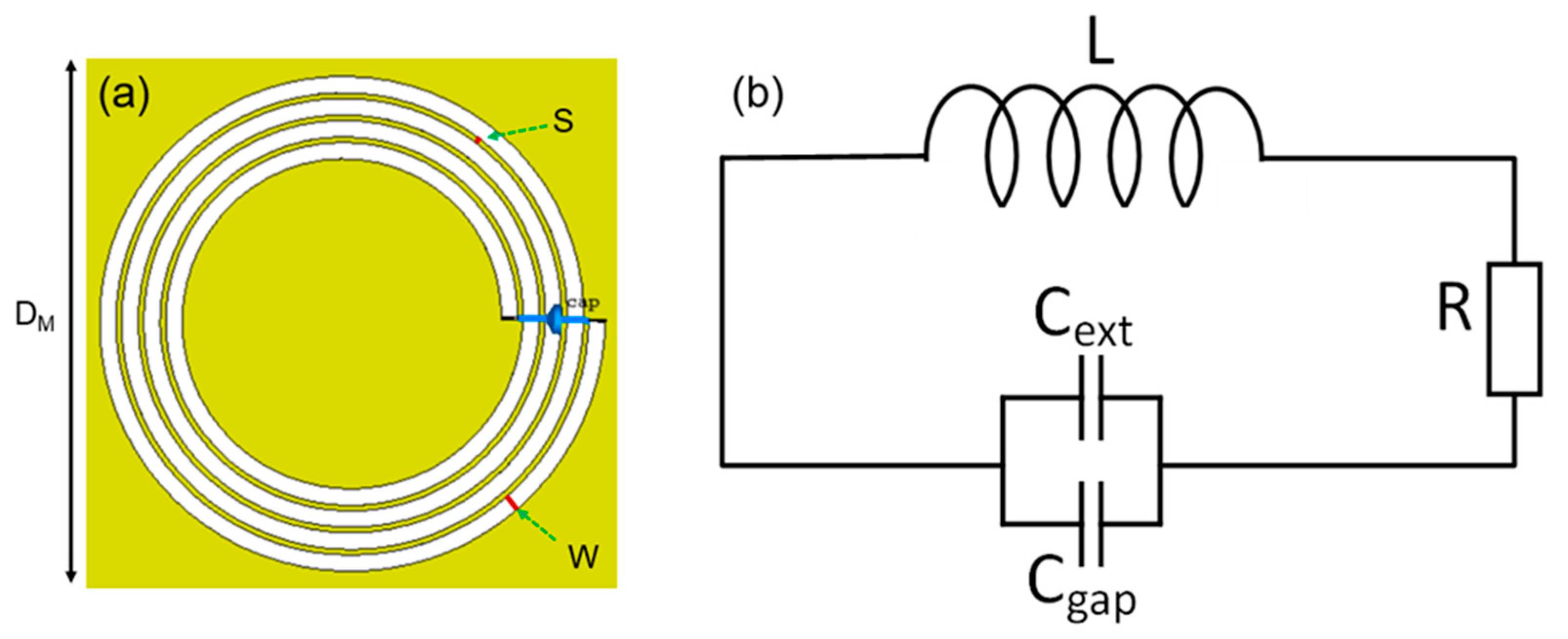
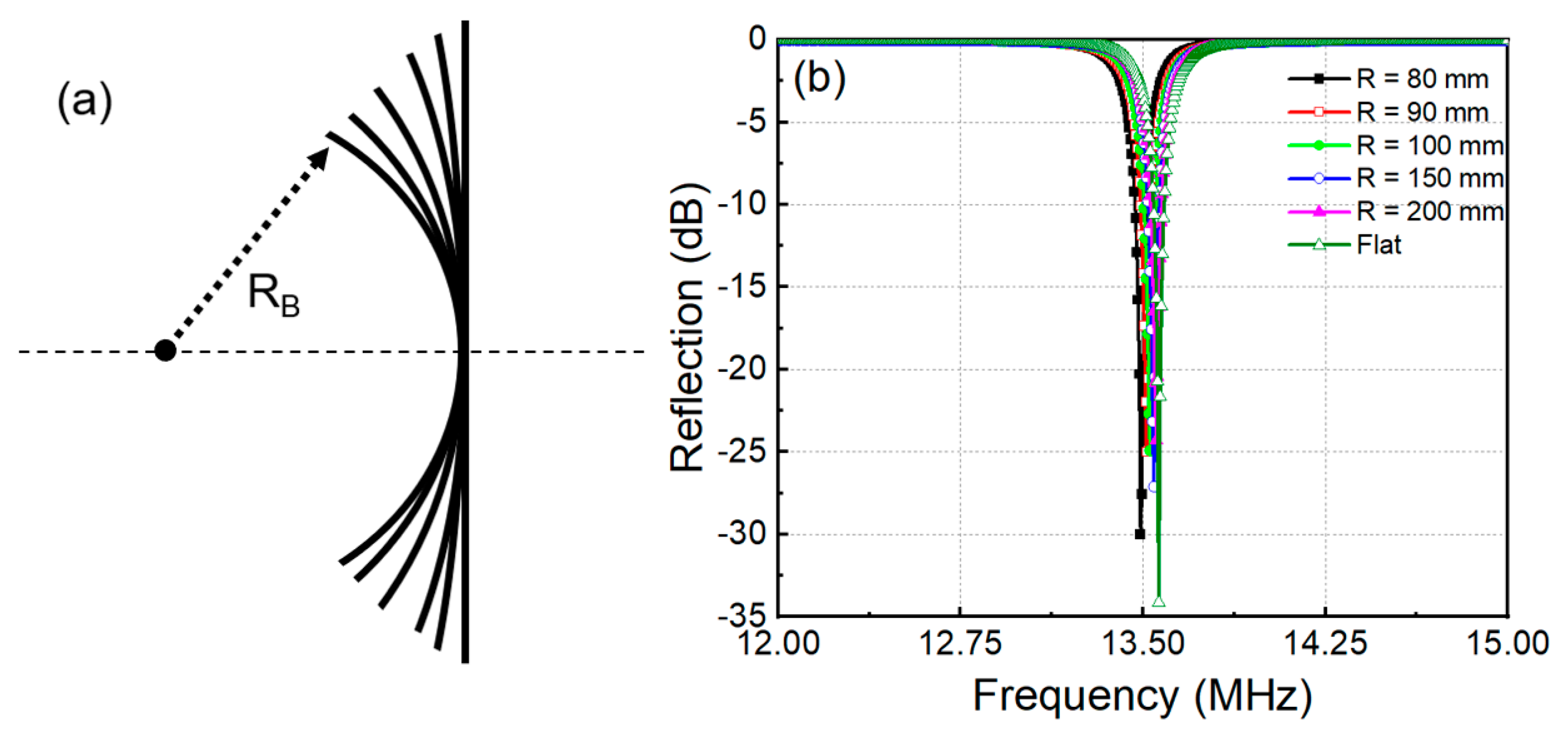
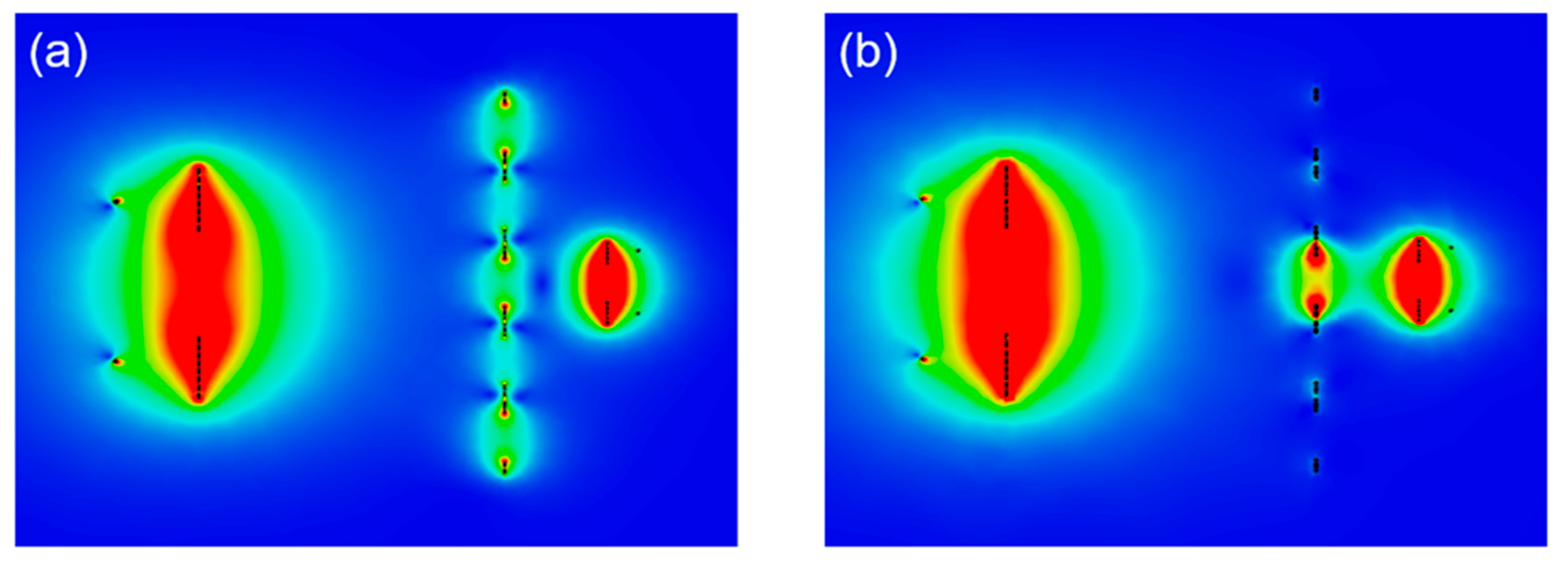
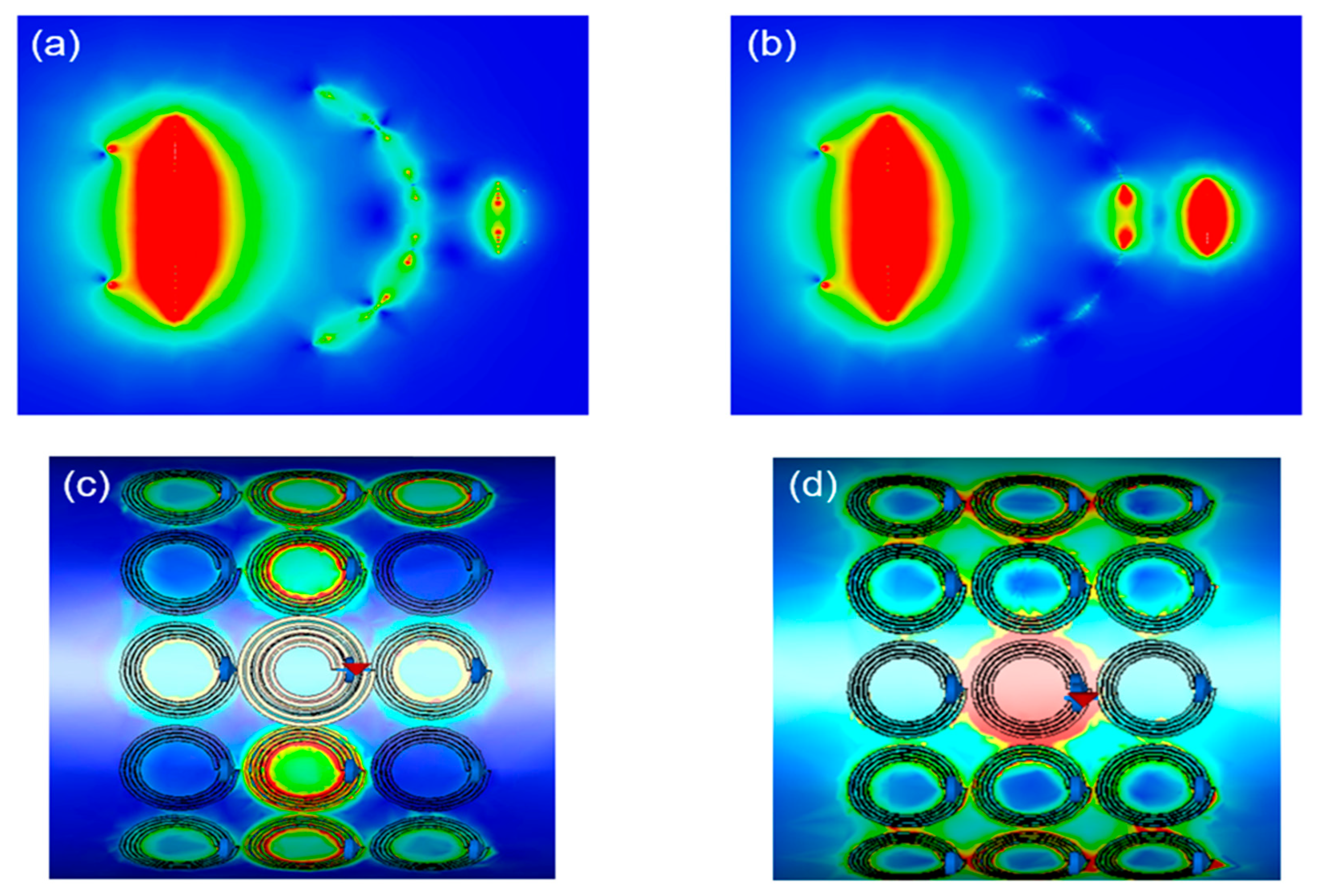

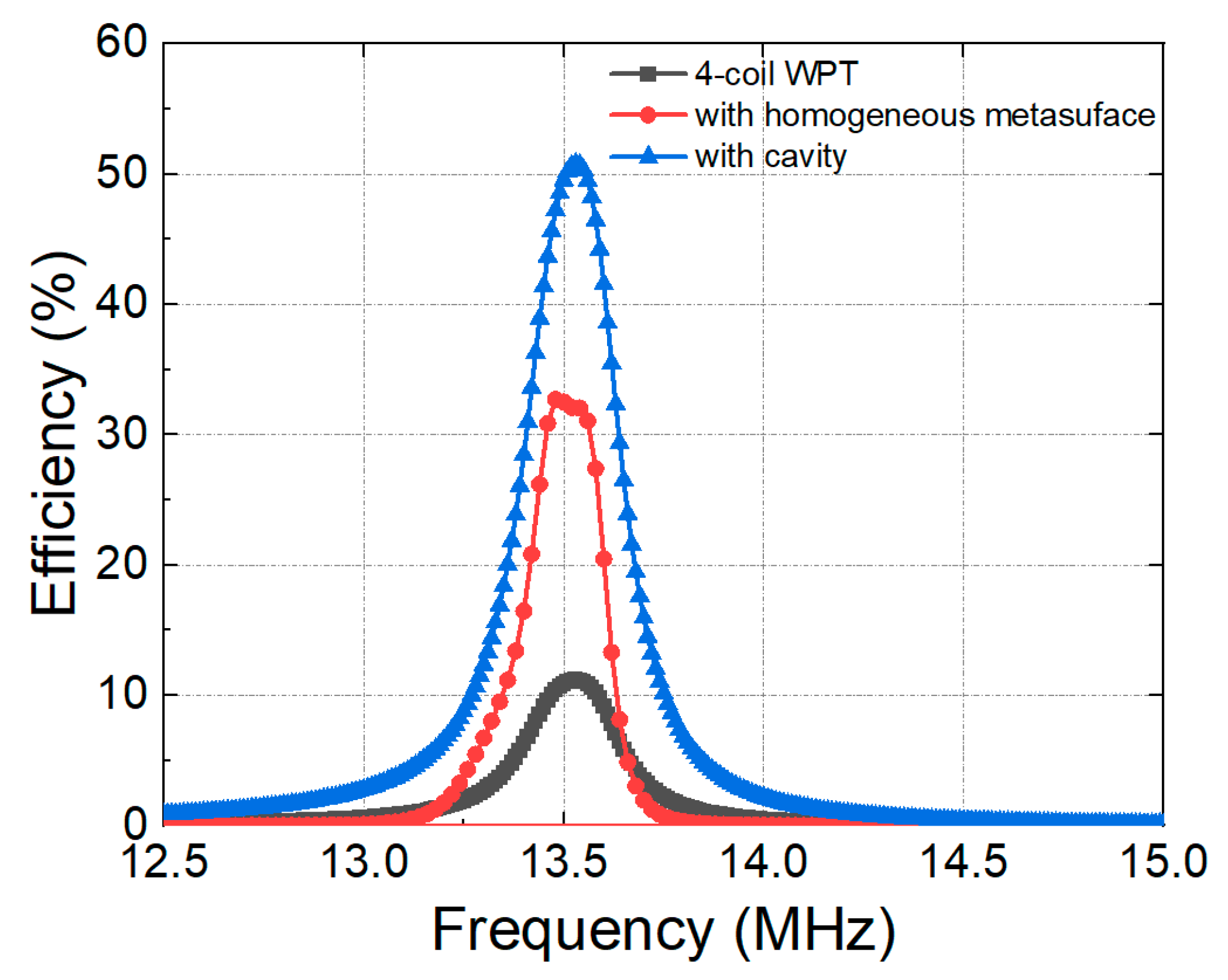
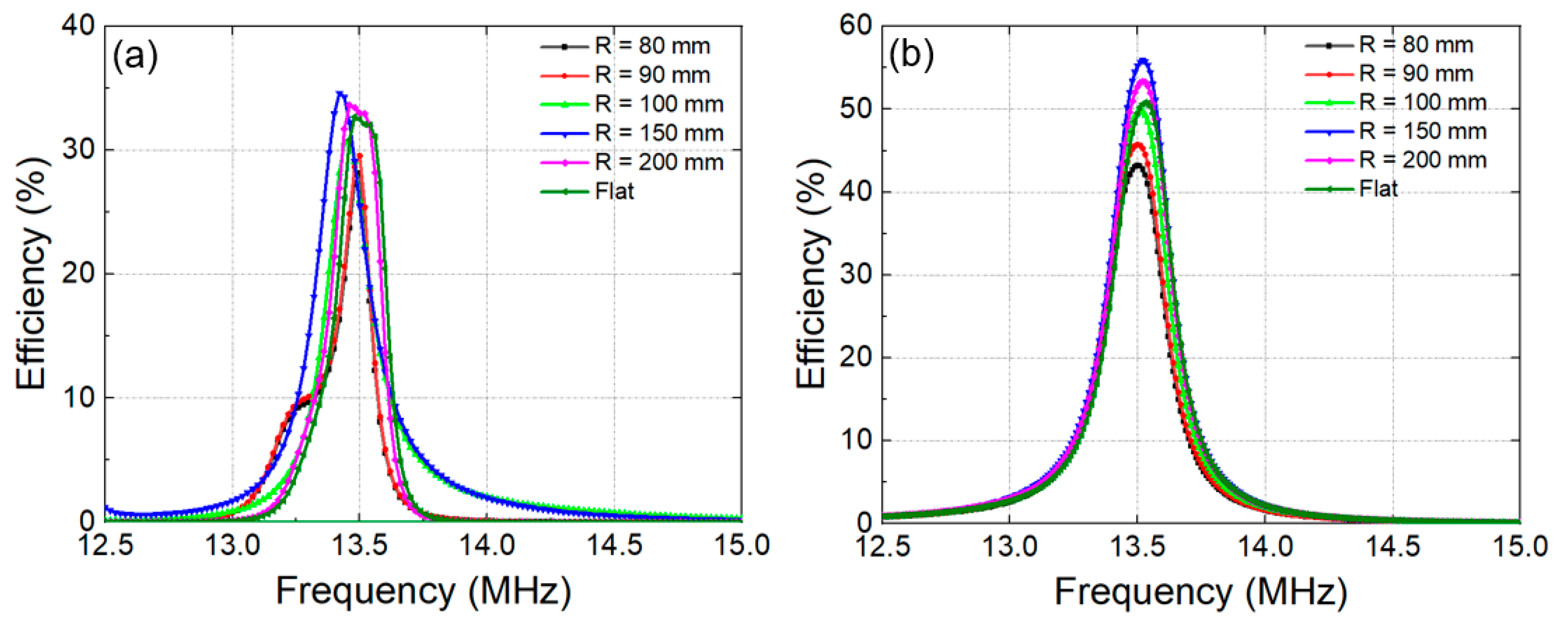
Publisher’s Note: MDPI stays neutral with regard to jurisdictional claims in published maps and institutional affiliations. |
© 2022 by the authors. Licensee MDPI, Basel, Switzerland. This article is an open access article distributed under the terms and conditions of the Creative Commons Attribution (CC BY) license (https://creativecommons.org/licenses/by/4.0/).
Share and Cite
Hiep, L.T.H.; Khuyen, B.X.; Tung, B.S.; Ngo, Q.M.; Lam, V.D.; Pham, T.S. Flexible Magnetic Metasurface with Defect Cavity for Wireless Power Transfer System. Materials 2022, 15, 6583. https://doi.org/10.3390/ma15196583
Hiep LTH, Khuyen BX, Tung BS, Ngo QM, Lam VD, Pham TS. Flexible Magnetic Metasurface with Defect Cavity for Wireless Power Transfer System. Materials. 2022; 15(19):6583. https://doi.org/10.3390/ma15196583
Chicago/Turabian StyleHiep, Le Thi Hong, Bui Xuan Khuyen, Bui Son Tung, Quang Minh Ngo, Vu Dinh Lam, and Thanh Son Pham. 2022. "Flexible Magnetic Metasurface with Defect Cavity for Wireless Power Transfer System" Materials 15, no. 19: 6583. https://doi.org/10.3390/ma15196583
APA StyleHiep, L. T. H., Khuyen, B. X., Tung, B. S., Ngo, Q. M., Lam, V. D., & Pham, T. S. (2022). Flexible Magnetic Metasurface with Defect Cavity for Wireless Power Transfer System. Materials, 15(19), 6583. https://doi.org/10.3390/ma15196583






